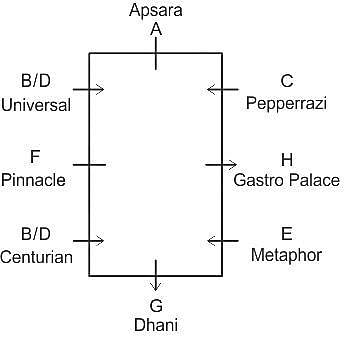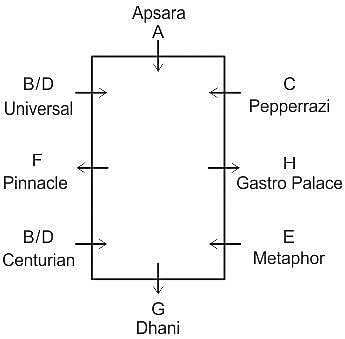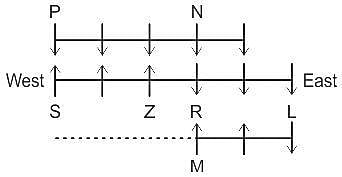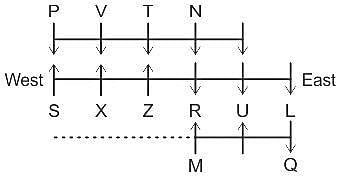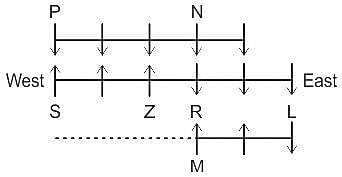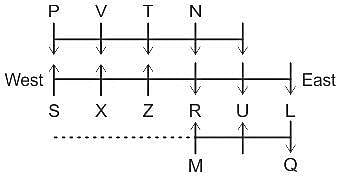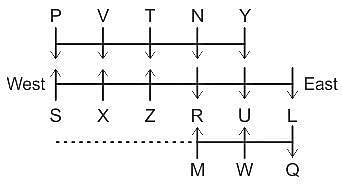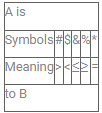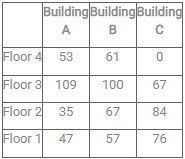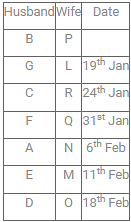IBPS Clerk Mains Mock Test - 4 - Banking Exams MCQ
30 Questions MCQ Test - IBPS Clerk Mains Mock Test - 4
Direction: Read the following information carefully and answer the question that follow.
Eight persons A, B, C, D, E, F, G and H are sitting around a rectangular table but not necessarily in the same order. Three persons sit on each of the longer side of the table and one on each shorter side of the table. Some of them are facing towards centre of the table and others are facing away from the centre. Each person went to a restaurant Apsara, Centurian, Dhani, Gastro Palace, Metaphor, Pepperrazi, Pinnacle, and Universal but not necessarily in the same order.
Three persons sit between G and A who went to Apsara. No one else sits on the same side as that of G who faces away from centre. The person who went to Universal sits third to the right of G.Two persons sit between the person who went to Universal and H who went to Gastro Palace. The person who went to Dhani sits second to the right of H. One person sits between G and F. The person who went to Pinnacle sits to the immediate left of the person who went to Centurian. The person who went to Pinnacle is not an immediate neighbour of the person who went to Dhani. Neither C nor E is an immediate neighbour of F. The person who went to Pepperrazi is not an immediate neighbour of G. The person who went to Metaphor and C both face towards the centre of the table. B and D face in same direction. The person who went to Apsara faces direction opposite to that of the person who sits opposite him. F faces direction opposite to that of the person who sits to his immediate right.
Q. What is the position of the person who went to Pinnacle with respect to C?
Direction: Read the following information carefully and answer the question that follow.
Eight persons A, B, C, D, E, F, G and H are sitting around a rectangular table but not necessarily in the same order. Three persons sit on each of the longer side of the table and one on each shorter side of the table. Some of them are facing towards centre of the table and others are facing away from the centre. Each person went to a restaurant Apsara, Centurian, Dhani, Gastro Palace, Metaphor, Pepperrazi, Pinnacle, and Universal but not necessarily in the same order.
Three persons sit between G and A who went to Apsara. No one else sits on the same side as that of G who faces away from centre. The person who went to Universal sits third to the right of G.Two persons sit between the person who went to Universal and H who went to Gastro Palace. The person who went to Dhani sits second to the right of H. One person sits between G and F. The person who went to Pinnacle sits to the immediate left of the person who went to Centurian. The person who went to Pinnacle is not an immediate neighbour of the person who went to Dhani. Neither C nor E is an immediate neighbour of F. The person who went to Pepperrazi is not an immediate neighbour of G. The person who went to Metaphor and C both face towards the centre of the table. B and D face in same direction. The person who went to Apsara faces direction opposite to that of the person who sits opposite him. F faces direction opposite to that of the person who sits to his immediate right.
Q. If B went to Centurian then how many persons sit between D and the person who went to Metaphor?
| 1 Crore+ students have signed up on EduRev. Have you? Download the App |
Direction: Read the following information carefully and answer the question that follow.
Eight persons A, B, C, D, E, F, G and H are sitting around a rectangular table but not necessarily in the same order. Three persons sit on each of the longer side of the table and one on each shorter side of the table. Some of them are facing towards centre of the table and others are facing away from the centre. Each person went to a restaurant Apsara, Centurian, Dhani, Gastro Palace, Metaphor, Pepperrazi, Pinnacle, and Universal but not necessarily in the same order.
Three persons sit between G and A who went to Apsara. No one else sits on the same side as that of G who faces away from centre. The person who went to Universal sits third to the right of G.Two persons sit between the person who went to Universal and H who went to Gastro Palace. The person who went to Dhani sits second to the right of H. One person sits between G and F. The person who went to Pinnacle sits to the immediate left of the person who went to Centurian. The person who went to Pinnacle is not an immediate neighbour of the person who went to Dhani. Neither C nor E is an immediate neighbour of F. The person who went to Pepperrazi is not an immediate neighbour of G. The person who went to Metaphor and C both face towards the centre of the table. B and D face in same direction. The person who went to Apsara faces direction opposite to that of the person who sits opposite him. F faces direction opposite to that of the person who sits to his immediate right.
Q. How many persons face towards the centre?
Direction: Read the following information carefully and answer the question that follow.
Eight persons A, B, C, D, E, F, G and H are sitting around a rectangular table but not necessarily in the same order. Three persons sit on each of the longer side of the table and one on each shorter side of the table. Some of them are facing towards centre of the table and others are facing away from the centre. Each person went to a restaurant Apsara, Centurian, Dhani, Gastro Palace, Metaphor, Pepperrazi, Pinnacle, and Universal but not necessarily in the same order.
Three persons sit between G and A who went to Apsara. No one else sits on the same side as that of G who faces away from centre. The person who went to Universal sits third to the right of G.Two persons sit between the person who went to Universal and H who went to Gastro Palace. The person who went to Dhani sits second to the right of H. One person sits between G and F. The person who went to Pinnacle sits to the immediate left of the person who went to Centurian. The person who went to Pinnacle is not an immediate neighbour of the person who went to Dhani. Neither C nor E is an immediate neighbour of F. The person who went to Pepperrazi is not an immediate neighbour of G. The person who went to Metaphor and C both face towards the centre of the table. B and D face in same direction. The person who went to Apsara faces direction opposite to that of the person who sits opposite him. F faces direction opposite to that of the person who sits to his immediate right.
Q. Who sits second to the left of the person who went to Gastro Palace?
Direction: Read the following information carefully and answer the question that follow.
Eight persons A, B, C, D, E, F, G and H are sitting around a rectangular table but not necessarily in the same order. Three persons sit on each of the longer side of the table and one on each shorter side of the table. Some of them are facing towards centre of the table and others are facing away from the centre. Each person went to a restaurant Apsara, Centurian, Dhani, Gastro Palace, Metaphor, Pepperrazi, Pinnacle, and Universal but not necessarily in the same order.
Three persons sit between G and A who went to Apsara. No one else sits on the same side as that of G who faces away from centre. The person who went to Universal sits third to the right of G.Two persons sit between the person who went to Universal and H who went to Gastro Palace. The person who went to Dhani sits second to the right of H. One person sits between G and F. The person who went to Pinnacle sits to the immediate left of the person who went to Centurian. The person who went to Pinnacle is not an immediate neighbour of the person who went to Dhani. Neither C nor E is an immediate neighbour of F. The person who went to Pepperrazi is not an immediate neighbour of G. The person who went to Metaphor and C both face towards the centre of the table. B and D face in same direction. The person who went to Apsara faces direction opposite to that of the person who sits opposite him. F faces direction opposite to that of the person who sits to his immediate right.
Q. Who went to Dhani?
If it is possible to make only one meaningful English word (starts with E and end also E) with the first, the second, the fourth, the fifth, the sixth and the seventh letters of the word BEWILDER, which of the following will be the fifth letter of that word? If no such word can be made give ‘X’ as the answer and if more than one such word can be made give ‘Y’ as the answer.
Direction: Read the instructions carefully and answer the question below
There are three rows i.e., row 1, row 2, and row 3 such that row 2 is to the north of row 3 and row 1 is to the north of row 2. Five persons are sitting in row 1 and 6 persons are sitting in row 2 and three persons are sitting in row 3.
Persons sitting in row 1 are facing South. In row 2 the first three persons sitting from West to East are facing North and the last three persons sitting from West to East are facing South. In row 3 first two persons sitting from west to east are facing North and the last person sitting in row 3 is facing South. All the persons are sitting at equal distance.
Four persons are sitting between S and L. S is facing P. Two persons are sitting between N and P. L is sitting second to the left of R. M is facing R and sits at one of the ends of the row. The position of Z with respect to S is same as the position of R with respect to L. The position of U with respect to Z is same as the position of Q with respect to M. V is facing X and is sitting to the immediate right of T. W is not an immediate neighbour of N. Y is one of the persons sitting in these rows.
Q. Who is facing U?
Direction: Read the instructions carefully and answer the question below
There are three rows i.e., row 1, row 2, and row 3 such that row 2 is to the north of row 3 and row 1 is to the north of row 2. Five persons are sitting in row 1 and 6 persons are sitting in row 2 and three persons are sitting in row 3.
Persons sitting in row 1 are facing South. In row 2 the first three persons sitting from West to East are facing North and the last three persons sitting from West to East are facing South. In row 3 first two persons sitting from west to east are facing North and the last person sitting in row 3 is facing South. All the persons are sitting at equal distance.
Four persons are sitting between S and L. S is facing P. Two persons are sitting between N and P. L is sitting second to the left of R. M is facing R and sits at one of the ends of the row. The position of Z with respect to S is same as the position of R with respect to L. The position of U with respect to Z is same as the position of Q with respect to M. V is facing X and is sitting to the immediate right of T. W is not an immediate neighbour of N. Y is one of the persons sitting in these rows.
Q. Who is sitting in second to the right of V?
Direction: Read the instructions carefully and answer the question below
There are three rows i.e., row 1, row 2, and row 3 such that row 2 is to the north of row 3 and row 1 is to the north of row 2. Five persons are sitting in row 1 and 6 persons are sitting in row 2 and three persons are sitting in row 3.
Persons sitting in row 1 are facing South. In row 2 the first three persons sitting from West to East are facing North and the last three persons sitting from West to East are facing South. In row 3 first two persons sitting from west to east are facing North and the last person sitting in row 3 is facing South. All the persons are sitting at equal distance.
Four persons are sitting between S and L. S is facing P. Two persons are sitting between N and P. L is sitting second to the left of R. M is facing R and sits at one of the ends of the row. The position of Z with respect to S is same as the position of R with respect to L. The position of U with respect to Z is same as the position of Q with respect to M. V is facing X and is sitting to the immediate right of T. W is not an immediate neighbour of N. Y is one of the persons sitting in these rows.
Q. Four of the pairs given below are similar in certain way and thus form a group. Find the pair that does not belong to the group.
Direction: Read the instructions carefully and answer the question below
There are three rows i.e., row 1, row 2, and row 3 such that row 2 is to the north of row 3 and row 1 is to the north of row 2. Five persons are sitting in row 1 and 6 persons are sitting in row 2 and three persons are sitting in row 3.
Persons sitting in row 1 are facing South. In row 2 the first three persons sitting from West to East are facing North and the last three persons sitting from West to East are facing South. In row 3 first two persons sitting from west to east are facing North and the last person sitting in row 3 is facing South. All the persons are sitting at equal distance.
Four persons are sitting between S and L. S is facing P. Two persons are sitting between N and P. L is sitting second to the left of R. M is facing R and sits at one of the ends of the row. The position of Z with respect to S is same as the position of R with respect to L. The position of U with respect to Z is same as the position of Q with respect to M. V is facing X and is sitting to the immediate right of T. W is not an immediate neighbour of N. Y is one of the persons sitting in these rows.
Q. Which three persons are sitting in row 3?
Direction: Read the instructions carefully and answer the question below
There are three rows i.e., row 1, row 2, and row 3 such that row 2 is to the north of row 3 and row 1 is to the north of row 2. Five persons are sitting in row 1 and 6 persons are sitting in row 2 and three persons are sitting in row 3.
Persons sitting in row 1 are facing South. In row 2 the first three persons sitting from West to East are facing North and the last three persons sitting from West to East are facing South. In row 3 first two persons sitting from west to east are facing North and the last person sitting in row 3 is facing South. All the persons are sitting at equal distance.
Four persons are sitting between S and L. S is facing P. Two persons are sitting between N and P. L is sitting second to the left of R. M is facing R and sits at one of the ends of the row. The position of Z with respect to S is same as the position of R with respect to L. The position of U with respect to Z is same as the position of Q with respect to M. V is facing X and is sitting to the immediate right of T. W is not an immediate neighbour of N. Y is one of the persons sitting in these rows.
Q. Who is sitting second to the left of T?
Direction: Read the given information carefully and answer the question asked.
For entering Republic day Parade Police ask code for a certain number for security reasons. The number can be combination of two-two digit number string or can be a single two-digit number. If the code is correct it allows the person to enter. The code can be generated in following manner.

Q. What could be the entry code for Step II code’1331’?
Direction: Read the given information carefully and answer the question asked.
For entering Republic day Parade Police ask code for a certain number for security reasons. The number can be combination of two-two digit number string or can be a single two-digit number. If the code is correct it allows the person to enter. The code can be generated in following manner.

Q. If Police says the STEP 1 code for a number is 39, then what will be the Entry code for the given number?
Direction: Read the given information carefully and answer the question asked.
For entering Republic day Parade Police ask code for a certain number for security reasons. The number can be combination of two-two digit number string or can be a single two-digit number. If the code is correct it allows the person to enter. The code can be generated in following manner.

Q. If the Police ask code for 46, what will be the entry code for Republic day Parade?
Direction: Read the given information carefully and answer the question asked.
For entering Republic day Parade Police ask code for a certain number for security reasons. The number can be combination of two-two digit number string or can be a single two-digit number. If the code is correct it allows the person to enter. The code can be generated in following manner.

Q. If the Police ask code for 73, what will be the entry code for Republic day Parade?
Direction: In the following question, the symbols #, $, &, % and * are used with the following meaning as illustrated below:
'A # B' means 'A is neither smaller than nor equal to B'.
'A $ B' means 'A is neither greater than nor equal to B'.
'A & B' means 'A is either less than or equal to B'.
'A % B' means 'A is either greater than or equal to B'.
'A * B' means 'A is neither smaller nor greater than B'.
Now in each of the following questions assuming the given statements to be true, find which of the conclusion/s given below them is/are definitely true?
Q. Statements:
P # Q, Q % R, R * S
Conclusions:
I. P # R
II. S * Q
Direction: In the following question, the symbols #, $, &, % and * are used with the following meaning as illustrated below:
'A # B' means 'A is neither smaller than nor equal to B'.
'A $ B' means 'A is neither greater than nor equal to B'.
'A & B' means 'A is either less than or equal to B'.
'A % B' means 'A is either greater than or equal to B'.
'A * B' means 'A is neither smaller nor greater than B'.
Now in each of the following questions assuming the given statements to be true, find which of the conclusion/s given below them is/are definitely true?
Q. Statements:
H % K, K # S, S & M
Conclusions:
I. H $ S
II. K # M
Direction: In the following question, the symbols #, $, &, % and * are used with the following meaning as illustrated below:
'A # B' means 'A is neither smaller than nor equal to B'.
'A $ B' means 'A is neither greater than nor equal to B'.
'A & B' means 'A is either less than or equal to B'.
'A % B' means 'A is either greater than or equal to B'.
'A * B' means 'A is neither smaller nor greater than B'.
Now in each of the following questions assuming the given statements to be true, find which of the conclusion/s given below them is/are definitely true?
Q. Statements:
L % M, M # N, N % T
Conclusions:
I. L # T
II. T $ M
Direction: Read the following information carefully and answer the question that follow:
There are six members in the family namely A, B, C, D, E and F. Each of them has different weights. C is lighter than only two people. F is heavier than only D. A is the not the heaviest. weight of A is 60 kg. The difference between the heaviest and the fourth heaviest is 10 kg. E is heavier than C but not the heaviest
Q. Which of the following is true if the weight of C is 66 kg?
Direction: Read the following information carefully and answer the question that follow:
There are six members in the family namely A, B, C, D, E and F. Each of them has different weights. C is lighter than only two people. F is heavier than only D. A is the not the heaviest. weight of A is 60 kg. The difference between the heaviest and the fourth heaviest is 10 kg. E is heavier than C but not the heaviest
Q. What is the possible weight of F?
The given question is followed by information in two statements. You have to find out which statement follows the information and mark your answer accordingly.
How is ‘teacher’ written in a code language?
Statements:
I. 'I am teacher' is written as 'op ne pa' and 'Happy teacher day' is written as 'pa ka jh'.
II. 'mother is best teacher' is written as 'xy lm pa hi' and 'My mother is teacher' is written as 'hi pa cr lm'.
The question is given below consist of a question followed by two statements labelled as I and II. You have to decide whether these statements give enough information required to answer the question or not.
Six friends P, Q, R, S, T and U have their seminar on 12, 15, 18, 21, 22 and 24 of the same month but not necessarily in the same order.
I. T and U have their seminar on 22nd and 24th respectively. Neither R nor Q has a seminar on 15th. P does not have a seminar on 18th.
II. T and U have their seminar on 22nd and 24th respectively. Only one person has a seminar between P and Q. Neither P nor Q has a seminar on 15th or 21st.
Who among the following has a seminar on 15th?
Direction: The question below consists of a question and two statements numbered I and II given below it. You have to decide whether the data provided in the statements are sufficient to answer the question. Read both the statements and give answer.
Seven persons M, N, O, P, Q, R and S are seated in a linear row not necessarily in the same order where P sits at left and Q sits at right end.
Q. Who among the following is sitting in the middle?
Statements:
I. S sits between R and Q.
II. O sits between N and P and N do not sit in the middle, who is second to the left of R. Person who sits between N and R is M.
Direction: Read the following information carefully and answer the question that follow.
There are three buildings, A, B and C, and each building has four floors, where topmost floor is numbered as floor 4 and bottommost floor is numbered as floor 1. Each floor has different number of tables. Building A is in west of building B, and building B is in west of building C.
Number of tables in each floor is given as follows:
Floor 4: 24, 32, 58
Floor 3: 94, 85, 52
Floor 2: 35, 67, 84
Floor 1: 47, 57, 76
A deck of 11 cards is taken which contains 5 face cards, 5 number cards and 1 joker card. Two cards are picked and the following conditions are to be followed.
I. If both cards are face cards, then 20 tables on floor 2 of building C will be shifted to the floor 4 of building B.
II. If both cards are number cards, then tables on floor 4 of building C will be divided equally among the floor 4 of buildings A and B.
III. If first card is face card and second card is number card, then 15 tables on floor 3 of building B will be shifted to the floor 4 of building A.
IV. If first card is number card and second card is face card, then all the tables on floor 2 will be equally divided among floor 2 of all the three buildings.
V. If a Joker card is picked, then 10 chairs will be added to each floor of each building.
Q. First 5 tables were removed from each floor of building A and then cards were picked. If one of the cards was Joker, then what is the total number of tables on Floor 4 of building A?
Direction: Read the following information carefully and answer the question that follow.
There are three buildings, A, B and C, and each building has four floors, where topmost floor is numbered as floor 4 and bottommost floor is numbered as floor 1. Each floor has different number of tables. Building A is in west of building B, and building B is in west of building C.
Number of tables in each floor is given as follows:
Floor 4: 24, 32, 58
Floor 3: 94, 85, 52
Floor 2: 35, 67, 84
Floor 1: 47, 57, 76
A deck of 11 cards is taken which contains 5 face cards, 5 number cards and 1 joker card. Two cards are picked and the following conditions are to be followed.
I. If both cards are face cards, then 20 tables on floor 2 of building C will be shifted to the floor 4 of building B.
II. If both cards are number cards, then tables on floor 4 of building C will be divided equally among the floor 4 of buildings A and B.
III. If first card is face card and second card is number card, then 15 tables on floor 3 of building B will be shifted to the floor 4 of building A.
IV. If first card is number card and second card is face card, then all the tables on floor 2 will be equally divided among floor 2 of all the three buildings.
V. If a Joker card is picked, then 10 chairs will be added to each floor of each building.
Q. The cards were drawn two times. In the first draw first card was a face card followed by a number card. In the second draw both cards were face cards. What will be the total number of tables on floor 4 of all buildings taken together?
Direction: Read the following information carefully and answer the question that follow.
There are three buildings, A, B and C, and each building has four floors, where topmost floor is numbered as floor 4 and bottommost floor is numbered as floor 1. Each floor has different number of tables. Building A is in west of building B, and building B is in west of building C.
Number of tables in each floor is given as follows:
Floor 4: 24, 32, 58
Floor 3: 94, 85, 52
Floor 2: 35, 67, 84
Floor 1: 47, 57, 76
A deck of 11 cards is taken which contains 5 face cards, 5 number cards and 1 joker card. Two cards are picked and the following conditions are to be followed.
I. If both cards are face cards, then 20 tables on floor 2 of building C will be shifted to the floor 4 of building B.
II. If both cards are number cards, then tables on floor 4 of building C will be divided equally among the floor 4 of buildings A and B.
III. If first card is face card and second card is number card, then 15 tables on floor 3 of building B will be shifted to the floor 4 of building A.
IV. If first card is number card and second card is face card, then all the tables on floor 2 will be equally divided among floor 2 of all the three buildings.
V. If a Joker card is picked, then 10 chairs will be added to each floor of each building.
Q. The cards were drawn two times. In the first draw first card was a number card followed by a face card. In the second draw one of the cards was a Joker card. What will be the total number of tables on Floor 2 of building A?
Direction: Read the following information carefully and answer the question that follow.
There are three buildings, A, B and C, and each building has four floors, where topmost floor is numbered as floor 4 and bottommost floor is numbered as floor 1. Each floor has different number of tables. Building A is in west of building B, and building B is in west of building C.
Number of tables in each floor is given as follows:
Floor 4: 24, 32, 58
Floor 3: 94, 85, 52
Floor 2: 35, 67, 84
Floor 1: 47, 57, 76
A deck of 11 cards is taken which contains 5 face cards, 5 number cards and 1 joker card. Two cards are picked and the following conditions are to be followed.
I. If both cards are face cards, then 20 tables on floor 2 of building C will be shifted to the floor 4 of building B.
II. If both cards are number cards, then tables on floor 4 of building C will be divided equally among the floor 4 of buildings A and B.
III. If first card is face card and second card is number card, then 15 tables on floor 3 of building B will be shifted to the floor 4 of building A.
IV. If first card is number card and second card is face card, then all the tables on floor 2 will be equally divided among floor 2 of all the three buildings.
V. If a Joker card is picked, then 10 chairs will be added to each floor of each building.
Q. There was a wedding in building A. So, for arrangements all the tables of building A were divided equally on each floor of building A. After the arrangements cards were picked. If both cards are face cards, then what is the difference in number of tables on floor 2 of building C and number of tables on floor 3 of building A?
Direction: Read the following information carefully and answer the question that follow.
There are three buildings, A, B and C, and each building has four floors, where topmost floor is numbered as floor 4 and bottommost floor is numbered as floor 1. Each floor has different number of tables. Building A is in west of building B, and building B is in west of building C.
Number of tables in each floor is given as follows:
Floor 4: 24, 32, 58
Floor 3: 94, 85, 52
Floor 2: 35, 67, 84
Floor 1: 47, 57, 76
A deck of 11 cards is taken which contains 5 face cards, 5 number cards and 1 joker card. Two cards are picked and the following conditions are to be followed.
I. If both cards are face cards, then 20 tables on floor 2 of building C will be shifted to the floor 4 of building B.
II. If both cards are number cards, then tables on floor 4 of building C will be divided equally among the floor 4 of buildings A and B.
III. If first card is face card and second card is number card, then 15 tables on floor 3 of building B will be shifted to the floor 4 of building A.
IV. If first card is number card and second card is face card, then all the tables on floor 2 will be equally divided among floor 2 of all the three buildings.
V. If a Joker card is picked, then 10 chairs will be added to each floor of each building.
Q. First 15 tables were added to Floor 3 of each building and then cards were picked. If both cards were number cards, then what is the total number of tables on Floor 3 and Floor 4 of building B?
Direction: Read the instructions carefully and answer the question below.
Seven boys A, B, C, D, E, F, and G got married to seven girls L, M, N, O, P, Q, and R but not necessarily in the same order. The number of days between any two marriages either before or after a marriage is more than 4 days but less than 8 days. For example, if a person got married on 10th March then the next person would have got married on 15th, 16th or 17th March. Not more than one couple got married on one date.
D got married after N. B was married before L. A got married on 6th February and Q was married immediately before A. Not more than four girls got married after R who got married in January. The difference between the number of days between the marriage of C and Q is the same as that of the marriage of E and O. The first couple got married six days before the second couple. No one got married on 25th Jan or 16th Feb. E got married immediately after N who is married to A. M got married 11 days after F. At least four girls got married before N. Nobody got married on 12th or 13th Feb. M got married after Q and M is not married to D. O got married after F. G was married five days before C.
Q. Who is the husband of R?
Direction: Read the instructions carefully and answer the question below.
Seven boys A, B, C, D, E, F, and G got married to seven girls L, M, N, O, P, Q, and R but not necessarily in the same order. The number of days between any two marriages either before or after a marriage is more than 4 days but less than 8 days. For example, if a person got married on 10th March then the next person would have got married on 15th, 16th or 17th March. Not more than one couple got married on one date.
D got married after N. B was married before L. A got married on 6th February and Q was married immediately before A. Not more than four girls got married after R who got married in January. The difference between the number of days between the marriage of C and Q is the same as that of the marriage of E and O. The first couple got married six days before the second couple. No one got married on 25th Jan or 16th Feb. E got married immediately after N who is married to A. M got married 11 days after F. At least four girls got married before N. Nobody got married on 12th or 13th Feb. M got married after Q and M is not married to D. O got married after F. G was married five days before C.
Q. On what date M got married?




